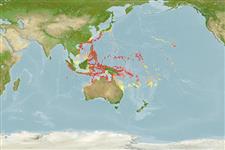Classification / Names
Common names from other countries
Main reference
Size / Weight / Age
Max length : 115 cm TL male/unsexed; (Ref. 90102)
Environment
Marine; reef-associated; depth range 1 - 30 m (Ref. 86942)
Climate / Range
Tropical, preferred ?; 38°N - 26°S, 96°E - 148°W
Distribution
Pacific Ocean: East Indies to the Society Islands, north to the Mariana Islands, south to Queensland; Mariana and Marshall Islands in Micronesia. Also in southern Japan (Ref. 637). Reported from India (Ref. 45255).
Countries | FAO areas | Ecosystems | Occurrences | Introductions
Short description
Vertebrae: 155 - 157. Body pale, almost white, with dark snout (Ref. 48635) and distinctive marking on back of head.
IUCN Red List Status (Ref. 115185)
Threat to humans
Harmless
Human uses
Fisheries: of no interest
More information
ReferencesAquacultureAquaculture profileStrainsGeneticsAllele frequenciesHeritabilityDiseasesProcessingMass conversion
Tools
Special reports
Download XML
Internet sources
Estimates of some properties based on models
Phylogenetic diversity index
PD50 = 0.5000 many relatives (e.g. carps) 0.5 - 2.0 few relatives (e.g. lungfishes)
Trophic Level
4.1 ±0.7 se; Based on size and trophs of closest relatives
Resilience
Medium, minimum population doubling time 1.4 - 4.4 years (Preliminary K or Fecundity.)
Vulnerability
Moderate to high vulnerability (53 of 100)
Price category
